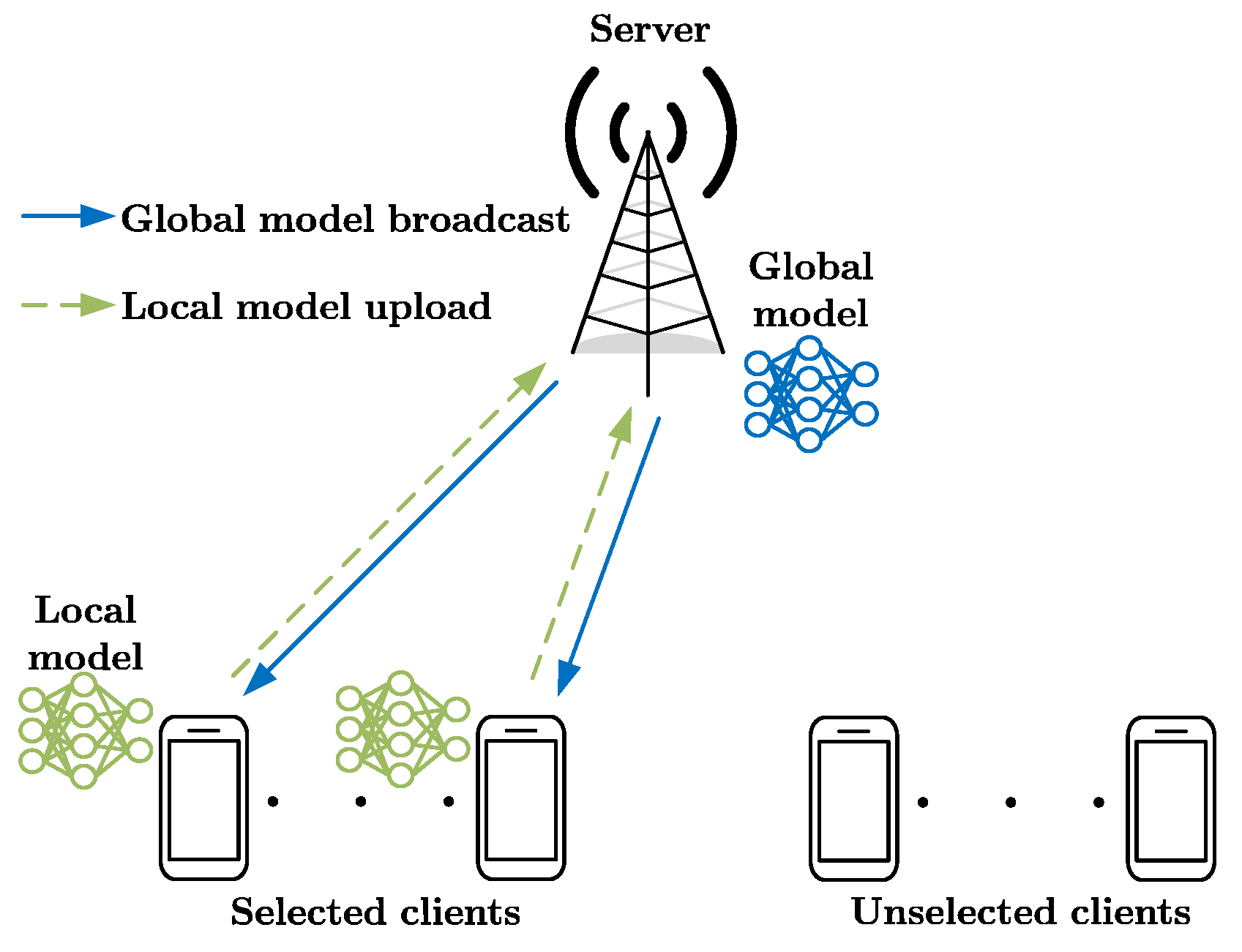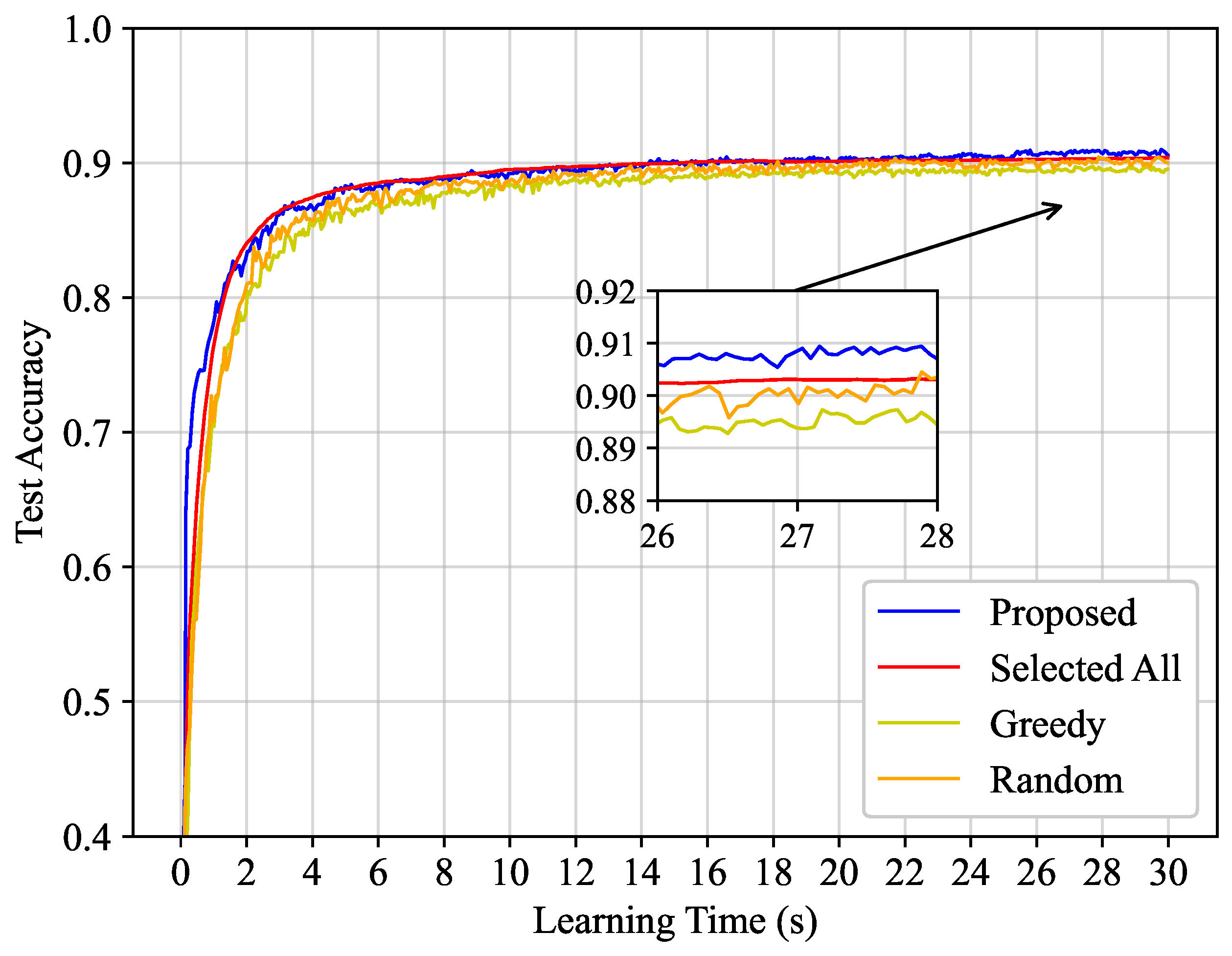Joint Client Selection and CPU Frequency Control in Wireless Federated Learning Networks with Power Constraints
Abstract
1. Introduction
1.1. Related Work
1.2. Contribution
- (1)
- We develop a comprehensive framework for the long-term client selection and CPU frequency control problem, taking into account the interdependence of different global iterations and long-term power consumption constraints for both clients and the server. The aim is to expedite the learning process by incorporating client and server latency, as well as the effect of the non-IID distribution of local training samples.
- (2)
- Leveraging Lyapunov optimization theory, we transform the long-term problem into a set of per-iteration problems. We introduce an algorithm to tackle the per-iteration problem, accompanied by a theoretical performance guarantee.
- (3)
- We conduct extensive experiments, inclusive of several comparative experiments. Simulation results demonstrate that our proposed algorithm can yield superior test accuracy while maintaining low power consumption.
2. System Model and Problem Formulation
2.1. Learning Model
- (1)
- Each client shares its side’s information. Subsequently, the server selects a group of clients and broadcasts the current global model to them.
- (2)
- The selected clients execute a local iteration to update their local models based on their respective datasets.
- (3)
- The selected clients upload their newly updated local models to the server.
- (4)
- The server aggregates all the received local models to establish a new global model, as represented by .
2.2. Power Consumption Model
2.3. Latency Model
2.4. Cost Model
2.5. Problem Formulation
3. Problem Solution and Algorithm Design
3.1. Problem Transformation via Stochastic Optimization Theory
3.2. Problem Solution
| Algorithm 1 Client Selection Algorithm |
|
3.3. Analysis of the Proposed Optimization Scheme’s Optimality
4. Experiment Result and Analysis
4.1. Experiment Settings
- Selected All: In this algorithm, all the clients are selected in each global iteration. The CPU frequency for both the clients and the central server is consistently set at their maximum values in every global iteration.
- Greedy: For a rational comparison with our proposed algorithm, the long-term average number of client selected per round is tuned to be consistent with that of our proposed algorithm in this comparative algorithm. As such, we establish a client selection latency threshold. Clients are subsequently chosen one by one in ascending order based on their individual total latency until the learning latency surpasses the preset client-selection latency threshold. Furthermore, with the prerequisite of adhering to the CPU frequency constraint, all participating clients and servers maintain a constant power level, identical to the long-term power constraint.
- Random: In this comparative algorithm, clients are randomly selected in each round. The number of clients selected is maintained at a constant value, which is equal to the average number per round in our proposed algorithm. Aside from this variation, all other configurations align with those of the Greedy algorithm.
4.2. Analysis of Experimental Results
5. Discussion
Author Contributions
Funding
Institutional Review Board Statement
Data Availability Statement
Conflicts of Interest
Abbreviations
| FL | Federated learning |
| IoT | Internet of Things |
| non-IID | Non-independent and identically distributed |
| IID | Independent identically distributed |
| OFDMA | Orthogonal frequency-division multiple access |
| MLP | Multi-layer perceptron |
| ReLU | Rectified Linear Unit |
Appendix A
Appendix B
Appendix C
Appendix D
References
- McMahan, B.; Moore, E.; Ramage, D.; Hampson, S.; y Arcas, B.A. Communication-efficient learning of deep networks from decentralized data. In Proceedings of the Artificial Intelligence and Statistics, Fort Lauderdale, FL, USA, 20–22 April 2017. [Google Scholar]
- Wang, S.; Tuor, T.; Salonidis, T.; Leung, K.K.; Makaya, C.; He, T.; Chan, K. Adaptive federated learning in resource constrained edge computing systems. IEEE J. Sel. Areas Commun. 2019, 37, 1205–1221. [Google Scholar] [CrossRef]
- Gao, W.; Zhao, Z.; Min, G.; Ni, Q.; Jiang, Y. Resource allocation for latency-aware federated learning in industrial internet of things. IEEE Trans. Ind. Inform. 2021, 17, 8505–8513. [Google Scholar] [CrossRef]
- Hu, R.; Guo, Y.; Gong, Y. Energy-efficient distributed machine learning at wireless edge with device-to-device communication. In Proceedings of the ICC 2022-IEEE International Conference on Communications, Seoul, Republic of Korea, 16–20 May 2022. [Google Scholar]
- Zhao, Z.; Feng, C.; Hong, W.; Jiang, J.; Jia, C.; Quek, T.Q.; Peng, M. Federated learning with non-iid data in wireless networks. IEEE Trans. Wirel. Commun. 2021, 21, 1927–1942. [Google Scholar] [CrossRef]
- Nishio, T.; Yonetani, R. Client Selection for Federated Learning with Heterogeneous Resources in Mobile Edge. In Proceedings of the ICC 2019—2019 IEEE International Conference on Communications (ICC), Shanghai, China, 20–24 May 2019. [Google Scholar]
- Leng, J.; Lin, Z.; Ding, M.; Wang, P.; Smith, D.; Vucetic, B. Client scheduling in wireless federated learning based on channel and learning qualities. IEEE Wirel. Commun. Lett. 2022, 11, 732–735. [Google Scholar] [CrossRef]
- Yang, Z.; Chen, M.; Saad, W.; Hong, C.S.; Shikh-Bahaei, M. Energy efficient federated learning over wireless communication networks. IEEE Trans. Wirel. Commun. 2020, 20, 1935–1949. [Google Scholar] [CrossRef]
- Yao, J.; Ansari, N. Enhancing federated learning in fog-aided IoT by CPU frequency and wireless power control. IEEE Internet Things J. 2020, 8, 3438–3445. [Google Scholar] [CrossRef]
- Zhao, Z.; Xia, J.; Fan, L.; Lei, X.; Karagiannidis, G.K.; Nallanathan, A. System optimization of federated learning networks with a constrained latency. IEEE Trans. Veh. Technol. 2021, 71, 1095–1100. [Google Scholar] [CrossRef]
- Yu, L.; Albelaihi, R.; Sun, X.; Ansari, N.; Devetsikiotis, M. Jointly optimizing client selection and resource management in wireless federated learning for internet of things. IEEE Internet Things J. 2021, 9, 4385–4395. [Google Scholar] [CrossRef]
- Chen, M.; Yang, Z.; Saad, W.; Yin, C.; Poor, H.V.; Cui, S. A joint learning and communications framework for federated learning over wireless networks. IEEE Trans. Wirel. Commun. 2020, 20, 269–283. [Google Scholar] [CrossRef]
- Liu, S.; Yu, G.; Chen, X.; Bennis, M. Joint user association and resource allocation for wireless hierarchical federated learning with iid and non-iid data. IEEE Trans. Wirel. Commun. 2022, 21, 7852–7866. [Google Scholar] [CrossRef]
- Huang, T.; Lin, W.; Wu, W.; He, L.; Li, K.; Zomaya, A.Y. An efficiency-boosting client selection scheme for federated learning with fairness guarantee. IEEE Trans. Parallel Distrib. Syst. 2020, 32, 1552–1564. [Google Scholar] [CrossRef]
- Guo, K.; Chen, Z.; Yang, H.H.; Quek, T.Q. Dynamic scheduling for heterogeneous federated learning in private 5g edge networks. IEEE J. Sel. Top. Signal Process. 2021, 16, 26–40. [Google Scholar] [CrossRef]
- Battiloro, C.; Di Lorenzo, P.; Merluzzi, M.; Barbarossa, S. Lyapunov-based optimization of edge resources for energy-efficient adaptive federated learning. IEEE Trans. Green Commun. Netw. 2022, 7, 265–280. [Google Scholar] [CrossRef]
- Xu, J.; Wang, H. Client selection and bandwidth allocation in wireless federated learning networks: A long-term perspective. IEEE Trans. Wirel. Commun. 2020, 20, 1188–1200. [Google Scholar] [CrossRef]
- Ji, Y.; Kou, Z.; Zhong, X.; Li, H.; Yang, F.; Zhang, S. Client Selection and Bandwidth Allocation for Federated Learning: An Online Optimization Perspective. In Proceedings of the GLOBECOM 2022—2022 IEEE Global Communications Conference, Rio de Janeiro, Brazil, 4–8 December 2022. [Google Scholar]
- Ji, X.; Tian, J.; Zhang, H.; Wu, D.; Li, T. Joint Device Selection and Bandwidth Allocation for Cost-Efficient Federated Learning in Industrial Internet of Things. IEEE Internet Things J. 2023, 10, 9148–9160. [Google Scholar] [CrossRef]
- Neely, M.J. Stochastic network optimization with application to communication and queueing systems. Synth. Lect. Commun. Netw. 2010, 3, 1–211. [Google Scholar]
- LeCun, Y.; Bottou, L.; Bengio, Y.; Haffner, P. Gradient-based learning applied to document recognition. Proc. IEEE 1998, 86, 2278–2324. [Google Scholar] [CrossRef]






| Average Power Consumption | Total Number of Clients | Proposed | Selected All | Greedy | Random |
|---|---|---|---|---|---|
| clients | 70 | 7016.21 mW | 113,212.66 mW | 5616.25 mW | 5600.00 mW |
| 80 | 8020.03 mW | 129,386.61 mW | 6401.84 mW | 6400.00 mW | |
| 90 | 9033.43 mW | 145,559.47 mW | 7229.53 mW | 7200.01 mW | |
| 100 | 10,036.40 mW | 161,733.26 mW | 7743.76 mW | 7800.00 mW | |
| 110 | 11,030.69 mW | 177,907.72 mW | 8439.06 mW | 8400.01 mW | |
| 120 | 12,053.63 mW | 194,080.37 mW | 9336.41 mW | 9300.01 mW | |
| 130 | 13,047.53 mW | 210,254.14 mW | 9940.70 mW | 9900.01 mW | |
| server | 70 | 499.86 mW | 3593.70 mW | 500.00 mW | 500.00 mW |
| 80 | 499.94 mW | 3593.70 mW | 500.00 mW | 500.00 mW | |
| 90 | 499.94 mW | 3593.70 mW | 500.00 mW | 500.00 mW | |
| 100 | 499.99 mW | 3593.70 mW | 500.00 mW | 500.00 mW | |
| 110 | 500.03 mW | 3593.70 mW | 500.00 mW | 500.00 mW | |
| 120 | 500.04 mW | 3593.70 mW | 500.00 mW | 500.00 mW | |
| 130 | 500.24 mW | 3593.70 mW | 500.00 mW | 500.00 mW |
Disclaimer/Publisher’s Note: The statements, opinions and data contained in all publications are solely those of the individual author(s) and contributor(s) and not of MDPI and/or the editor(s). MDPI and/or the editor(s) disclaim responsibility for any injury to people or property resulting from any ideas, methods, instructions or products referred to in the content. |
© 2023 by the authors. Licensee MDPI, Basel, Switzerland. This article is an open access article distributed under the terms and conditions of the Creative Commons Attribution (CC BY) license (https://creativecommons.org/licenses/by/4.0/).
Share and Cite
Zhou, Z.; Shi, S.; Wang, F.; Zhang, Y.; Li, Y. Joint Client Selection and CPU Frequency Control in Wireless Federated Learning Networks with Power Constraints. Entropy 2023, 25, 1183. https://doi.org/10.3390/e25081183
Zhou Z, Shi S, Wang F, Zhang Y, Li Y. Joint Client Selection and CPU Frequency Control in Wireless Federated Learning Networks with Power Constraints. Entropy. 2023; 25(8):1183. https://doi.org/10.3390/e25081183
Chicago/Turabian StyleZhou, Zhaohui, Shijie Shi, Fasong Wang, Yanbin Zhang, and Yitong Li. 2023. "Joint Client Selection and CPU Frequency Control in Wireless Federated Learning Networks with Power Constraints" Entropy 25, no. 8: 1183. https://doi.org/10.3390/e25081183
APA StyleZhou, Z., Shi, S., Wang, F., Zhang, Y., & Li, Y. (2023). Joint Client Selection and CPU Frequency Control in Wireless Federated Learning Networks with Power Constraints. Entropy, 25(8), 1183. https://doi.org/10.3390/e25081183





